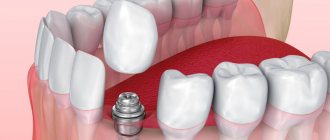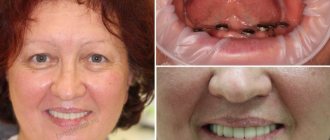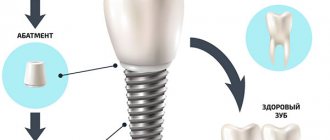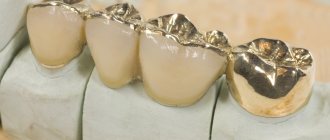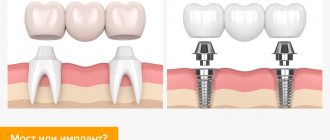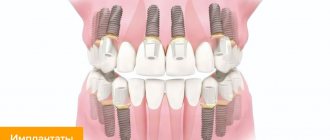Implantation of chewing teeth – upper and lower. Which implant and crown is best for chewing teeth? Which is better, a bridge or an implant? Specialists at the Implantmaster clinic will select the best option for implanting chewing teeth using the latest diagnostic equipment. We use premium implantation systems at affordable prices.
Despite the increased strength of teeth in the chewing area, they are more susceptible than others to carious lesions, inflammatory processes and losses. Moreover, when units are lost in this area, serious aesthetic problems and disturbances in the functioning of the gastrointestinal tract can occur. All of the above negative manifestations are due to the direct participation of teeth in the process of chewing food and, as a result, excessive load. To eliminate such a pathology, it is necessary to urgently contact dentistry to perform implantation.
At the Implantmaster clinic, the process of recreating teeth in the chewing department is carried out by experienced specialists, based on modern protocols, using special surgical templates and innovative digital equipment. This significantly increases the accuracy of the procedures, minimizes pain, shortens the period of implementation and ensures a successful and long-term result.
Next, we will talk in more detail about implantation of chewing teeth , consider the specifics of performing the procedure in the maxillary and mandibular regions, and also introduce you to the pricing policy and existing reviews. We hope that the information received will help you draw the right conclusions about the need to install implants on your chewing teeth, and you will learn to understand its intricacies.
Get a consultation
We will answer all your questions before visiting the clinic!
+7
Online registration
Content
1 What are the consequences of losing teeth in the chewing area?
2 Implantation of chewing teeth on the upper jaw
3 Implants of the lower chewing teeth
4 Which implant is better to place on chewing teeth?
5 Bone grafting for implantation of lateral teeth
6 Which crowns are best fixed to a chewing tooth implant?
7 Methods of implantation of chewing teeth
8 Which is better – a bridge or an implant for chewing teeth?
9 Prices for implantation of chewing teeth
10 Reviews about implantation of chewing teeth
11 Alternative options
Where to go for molar implantation in Moscow
Dental implants eliminate discomfort, stimulate bone tissue and gums, and provide a stable base for artificial teeth. Implantation of molars provides comfort to patients and normal performance of chewing functions. Implants are biocompatible, guarantee long-term prosthetic reconstruction, preserve healthy teeth and are an excellent means of preventing bone loss.
- The absence of one chewing tooth is one of the indications for implantation. The advantage is that the adjacent teeth remain intact. In traditional bridge making, the teeth have to be prepared. While implantation of molars does not require intervention in neighboring units, the crown on the implant completely replaces the lost tooth in terms of functionality.
- If several natural teeth are lost, implants can be used to form the basis of a bridge. Healthy teeth remain intact, and the prosthesis is firmly fixed to the implants. There is no need for inconvenient clasps and other supports for orthopedic structures. A bridge prosthesis on implants 100% restores impaired chewing functions.
Contact specialists in the implantation of chewing teeth in Moscow if you have single or multiple defects. Approximate prices for such services are shown in the table below. Remember, the choice of dentistry and doctor is the key to a successful result!
| Name | Clinic address | Service cost |
| ROOTT |
|
|
| Shandora | Moscow, Kolpachny lane, 6, building 4. |
|
| Dentistry Grand Smile | Moscow, st. Miklouho-Maklaya 43 (metro station Belyaevo, Yugo-Zapadnaya, Kaluzhskaya) | Prices for dental implantation from 30,000 rubles (MIS system) to 70,000 rubles (Nobel) |
| Dentistry City Dent | Moscow, st. Novocheremushkinskaya, 57 | Implantation of one tooth with the Astra Tech system – 52,000 rubles |
| Dentistry Vita-Stom |
| Implantation of one tooth with the Straumann system (Switzerland) – from 32,000 rubles. |
We remind you that treatment with implants is one of the most modern solutions used in dentistry. They restore the correct function of the masticatory system and avoid grinding down healthy teeth. Using implants, you can find an individual and comfortable solution to your dental problems. But there are also contraindications to the procedure.
- Relative contraindications: allergies, cardiovascular diseases, advanced periodontitis, inflammation in the oral cavity, kidney disease, smoking.
- Absolute: pregnancy, age under 16 years, diabetes, AIDS, tumor diseases, alcoholism, epilepsy.
Other jobs
What are the consequences of losing teeth in the chewing area?
Despite their reliability, molars and premolars are among the most susceptible teeth to pathogenic bacteria. This is due to their active participation in the process of chewing food products. Severe pathologies in the chewing area can provoke tooth loss. This, in turn, can cause such serious problems as deterioration of the anatomical characteristics of the face, disturbances in the functioning of the maxillofacial system, disruptions in the functioning of the gastrointestinal tract and other undesirable changes.
Currently, the most effective method of eliminating the defect is the implantation of chewing teeth. However, the procedure for reproducing molars and premolars differs in its specific features, which we will discuss later.
Clinical cases
Dentists emphasize the need for timely restoration of molars and premolars. The absence of teeth in the chewing area does not allow you to fully chew food, which provokes problems with the gastrointestinal tract. Atrophic processes lead to loss of volume of the jaw bone, on which soft tissues rest.
If the dentition is not restored for a long time, deformation changes in the anatomy of the face occur. The facial muscles stretch towards the defect, sag, and patients note the premature appearance of wrinkles. Cosmetic procedures are ineffective if you have an incomplete set of teeth! Only a dentist who will select the appropriate method of prosthetics can help get rid of these problems.
1. Single and scattered defects (if the tooth has been missing for a long time or needs to be removed)
For single restorations, two-stage or one-stage implantation is used. If a unit of the dentition has been missing for a long time, the classical technique is often used. Reliable ingrowth of the implant guarantees its resistance to chewing loads. When a tooth is to be removed, the doctor will suggest placing a titanium support in a fresh socket with immediate loading with a crown.
2. Missing teeth in a row on one side
For multiple restorations, a single-stage protocol with immediate loading is suitable. To do this, install two or more supports. If the defect is extensive, 3-4 implants with special abutments are installed on which the orthopedic structure will be supported. The adaptation prosthesis is reinforced with a titanium arch. Thanks to it, the implants do not loosen and grow into the jaw. The prosthesis can be fixed using cement or screws.
3. Missing teeth on both sides
To replace molars and premolars located on opposite sides of the dentition, classical implantation systems and techniques with simultaneous loading of the prosthesis are used. But the health of the front teeth should be assessed. If they are in poor condition, surgical removal with simultaneous placement of implants is recommended. Several more artificial roots are installed in the side zone. Their loading with the prosthesis occurs after 2-3 days.
Implantation of chewing teeth in the upper jaw
It should be noted that the maxillary and mandibular sections have their own unique specific structure. In this case, an important point when losing a tooth in the upper jaw is rapid atrophy. That is, if several years have passed since the loss of such a unit, then a necessary condition for successful fixation of implants will be raising the lower part of the maxillary cavity (performing a sinus lift).
If the tooth is subject to extraction or its loss occurred not so long ago, you can resort to instant methods. During them, the fixation of the prosthetic device is carried out immediately after the insertion of the chewing tooth implant. Due to instant loading, an accelerated period of osseointegration is achieved, equal to 12-16 weeks (3-5 weeks with Straumann implants).
The implant of the upper chewing tooth can also be fixed using the traditional method, which involves step-by-step treatment. However, the load in this case can be carried out only after the end of the engraftment period.
When deciding to install an upper posterior dental implant, you should be aware of the risks associated with this procedure. They are caused, first of all, by the proximity of the maxillary cavities. With an incompetent approach, there is an increased likelihood of injury and the appearance of inflammatory processes.
In our dentistry, consultations are conducted by competent specialists who know all the intricacies of fixation of dental systems in the maxillary region. This guarantees the safety of the manipulations and ensures a prolonged result without complications.
Causes of loss of lateral teeth
Chewing teeth are more likely to suffer from caries than other teeth. This is due to the larger surface of the tooth on which bacteria form and the difficulty of cleaning it. If a person is missing at least one lateral tooth, the remaining teeth are no longer positioned correctly, and the chewing load is distributed unevenly. This can lead to bone atrophy. If the problem of missing teeth is not eliminated for many years, a person will face ankylosis - a limitation in the performance of the lower jaw.
Causes of tooth loss:
- Pulpitis, caries, other dental diseases.
- Inflammation of the gums (periodontal disease, periodontitis).
- Large growths near the roots of the teeth.
Our team of doctors
Maxillofacial surgeon, Implantologist
Bocharov Maxim Viktorovich
Experience: 11 years
Dental surgeon, Implantologist
Chernov Dmitry Anatolievich
Experience: 29 years
Orthopedist, Neuromuscular dentist
Stepanov Andrey Vasilievich
Experience: 22 years
Endodontist, Therapist
Skalet Yana Alexandrovna
Experience: 22 years
Orthopedic dentist
Tsoi Sergey Konstantinovich
Experience: 19 years
Dentist-orthodontist
Enikeeva Anna Stanislavovna
Experience: 3 years
Stages of implantation with immediate loading
Installation of implants and temporary prosthetics is carried out in one visit. Installation of permanent structures - after the implants have fused with the bone.
- Implant installation is carried out under local anesthesia or sedation. It is possible to install it in the socket of an extracted tooth. For full implantation, a surgical template is used.
- Immediate prosthetics A temporary plastic crown is immediately installed for a single restoration or a prosthesis for complete restoration of teeth.
- Permanent prosthetics When the implant fuses with the bone, the temporary crown is replaced with a zirconium crown, and the adaptive prosthesis with the one specified in the protocol.
A permanent crown can be placed after 3-4 months. In cases where the bite is restored and the masticatory muscles begin to work as usual, it can be installed earlier (assessed during control CT examinations). Complete permanent dentures are installed within a period of 6 months to a year.
Implantation in our Center is performed only by maxillofacial surgeons and implantologists with daily work experience of at least 5 years. These are first-class specialists with developed clinical thinking and sufficient practical skills. They are fluent in Nobel Biocare® surgical protocols and undergo annual training based on the company’s educational programs.
Implants of the lower chewing teeth
If you require implantation in the lower jaw in the area of chewing teeth, then there is a high probability that this procedure will be carried out using a two-stage method. During the first step, the specialist will perform surgery, after which he will suture the gum tissue. At the second stage, the prosthetic device is fixed, a prerequisite for which is complete engraftment of the dental implant.
It should be noted that if implants of the lower chewing teeth are installed using classical technology, this requires the presence of bone tissue with sufficient density and height. If a CT scan reveals a lack of bone tissue, osteoplasty is an integral part of the implantation. This manipulation involves the transplantation of donor or artificial bone blocks.
The treatment period in this case can be significantly delayed, which is explained by the need to restore bone tissue and achieve the required parameters. But in some situations, the osteoplastic procedure can be performed simultaneously with the introduction of dental structures.
In our dentistry, you can get advice from qualified specialists, which will allow you to determine the need for osteoplastic procedures. In addition, we use the latest oral scanners, which guarantees highly accurate diagnostics and proper planning of further treatment measures.
Work examples
All works
Basal implantation for end defect
One-stage implantation for end defect
Implantation with screw fixation of chewing teeth
Implantation of chewing teeth
Restoration of chewing teeth using ROOTT system implants
End defect
Classical dental implantation
Implantation on multi-unit posterior teeth
Dental restoration using classic ROOTT system implants
Installation of one-stage implants with screw fixation in 3 days
One-stage implantation of three chewing teeth
One-stage implantation in 4 days
One-stage implantation with immediate loading (masticatory group)
Classical implantation of the chewing teeth
All works
Sign up for a consultation
three ROOTT specialists + diagnostics as a gift
Which implant is best for chewing teeth?
It is a mistake to believe that doctors use the same type of implants to recreate all teeth. For each individual situation, a different method of prosthetics and implantation system are used, which guarantees the success of the procedure in terms of aesthetic and functional parameters.
First of all, in order to understand which implant is best to place on chewing teeth, you should take into account the anatomical parameters of the jaw structure. Taking into account these features, the doctor selects the size of the implant for the chewing tooth.
If we talk about methods of recreating teeth in the lateral region, most often the traditional method is used here, which involves a step-by-step procedure. In this case, the dental system is initially fixed, and only 12-24 weeks after this, the orthopedic structure is installed. The unique SLActive surface from ]Straumann[/anchor] reduces this period to 3-5 weeks. This is due to the need for high-quality osseointegration of the system with bone tissue. During the healing period, the patient usually wears a temporary prosthetic device.
Almost all modern manufacturers have dental implants in their arsenal, designed to restore teeth in the chewing area. Both premium quality systems and budget models are suitable for this purpose. However, products from the Swiss brand Straumann allow you to get the best aesthetic effect and achieve the necessary functionality. In any case, only a competent specialist in a trusted dental clinic can Which implant is better to place on chewing teeth?”
We offer significant discounts on the installation of top-end implantation systems, which allows you to get an impeccable result with a long guarantee. You can also get competent advice from our doctors regarding which implants are best placed on chewing teeth. Our specialists have impressive experience in restoring the aesthetics and functionality of the side section.
Rating of dental implant manufacturers »
Bone grafting for implantation of lateral teeth
It is not possible to fix molar implants in the chewing area if there is a deficiency of bone tissue; an osteoplastic procedure is mandatory. We discussed this point in the previous paragraphs of the article. The process of increasing the size of bone tissue is performed by raising the lower part of the maxillary cavities (in the maxillary region), or by transplanting bone contents (in the maxillary region).
It will not hurt to know that only implantation can stop the process of bone tissue resorption. That is, if the question arises: “ Crown or implant for chewing teeth?”, we can definitely speak in favor of the latter option. As for the removable orthopedic structure, the process of bone loss continues to progress even after its installation.
Read more about bone grafting for dental implants »
When can an implant be placed, and when should an implant not be placed?
Let's start with problems when implantation was postponed
Let’s not go into the reasons now - either due to the patient’s ignorance, or he is lazy, or there is fear of the operation. It doesn't matter now. The main thing is that there is a time delay in installing the implant. Let's understand where exactly this problem arises if the patient nevertheless decides to postpone implantation.
The very phrase “bone tissue has resolved” does not sound scary and does not frighten a person who does not understand dentistry.
What are the consequences and dangers of bone tissue resorption?
Let’s say we can consider the overall picture: if a patient has no teeth, then he chews food worse, therefore, he has worse digestion, etc. and so on. That is, the patient’s body as a whole suffers more. And if you look in particular, that is, into the oral cavity, then it is easier - it’s just inconvenient to chew food. Although some people manage to chew food without teeth at all. How they manage to do this is difficult to say.
In general, a person adapts to many problems
First he gets used to the absence of one tooth, then two or three, etc. then it loses even more, chewing food becomes not such an important factor. But in vain.
That is, a person is adapting to the created conditions with his teeth, or more precisely, to their absence. And then, when he gets all his teeth back - during the restoration of both the upper and lower jaws, the person becomes... unusual for chewing! They even ask again: “How can I chew it now? I’m used to doing it differently.” It sounds quite anecdotal, but the patient is not laughing at this moment; he has to learn to chew food normally again.
What other factor can attract the attention of the patient, especially women?
, regarding the situation with a missing tooth?
The aesthetics factor of the anterior teeth is very important
If you lose one or two teeth in the chewing department, no one will notice a violation of aesthetics. And if in the anterior region, then yes, the speed of decision-making about installing an implant and further prosthetics is very high, since the patient wants to eliminate a visible dental defect as soon as possible.
Plus, due to the absence of front teeth, there is a retraction of soft tissues, which is visible to the eyes of strangers.
For some reason, patients almost always postpone restoration of the chewing group of teeth through implantation “for later,” although this is wrong
.
It is necessary to restore the chewing area so that it bears the chewing load. If the chewing zone is not restored, then, oddly enough, the frontal, anterior zone of the teeth begins to suffer first.
The front teeth take the load of the chewing teeth and become overloaded: the front teeth begin to bear a load many times greater than what Nature assigned them. As a result of such maximum loads, the ligaments are stretched and the teeth become loose. And at this moment the patient begins to ask himself (and the doctor): “Why are my teeth loose?” And he even diagnoses himself - periodontal disease or periodontitis. But in fact, the patient does not have any periodontal disease or periodontitis; the chewing teeth just need to be restored.
When a patient comes to me at the German Center for aesthetics, then always, if he has a lack of chewing teeth or there is a functional deficiency (that is, crowns that are not restored correctly, chipped crowns, teeth that are destroyed or fillings that are not restored very well), then I always I draw his attention, telling him that first he needs to restore his chewing teeth.
See how this happens in the example of one patient:
And only then – we begin to talk about restoring a smile, about aesthetics:
Because, having made the chewing teeth, we will move the load to its “native” place, normalize the load in the frontal region, and the work that we will then do with the front teeth - veneers, crowns - this work will last happily ever after for many years.
Consent to dental implantation “immediately” and “not immediately”
What happens if the patient:
- immediately agrees to install the implant,
- Will he agree to have an implant installed after some time?
How is the implant installed in these cases? The difference in implant placement in these cases is large
.
Case 1.
If a patient comes and says: “I have a bad toothache and I want to get an implant,” you must first understand why his tooth hurts. If this tooth hurts because it is mobile, and for some reason the mobility affects the gums - that is, the gums actually hurt, this is one case.
Case 2.
But if the tooth hurts, and a large cyst or abscess is identified in the area of the tooth, then this is a different case. Why does an abscess form? It is formed due to the destruction of bone tissue, due to the localization of infection in this destroyed area. And this infection was activated, and a purulent process had already appeared. And this is exactly what hurts. Naturally, in this case, the implant cannot be installed immediately. Because the surrounding tissues are infected, and even if everything is cleaned well and an implant is placed (if there is somewhere to place it, if the bone tissue is not completely destroyed), then there is a high probability of implant rejection. The implant may not take root and may not generate osteogeneration, because the body has not yet stabilized the area of inflammation and has not brought it “in order.” The processes of bone tissue regeneration and the processes of fouling of the implant with bone tissue will not be carried out; the body will simply reject the implant as a foreign body.
Case 3.
If the patient comes, and for some reason he needs to have a tooth removed, and there is an infection (granuloma or small cyst).
Dental implantation if a cyst is detected
People come and say: “I was diagnosed with a cyst. What to do?". The concept of a cyst is very different. First it is a granuloma, then it is a cystogranuloma, and only then it is a cyst. It depends on the size, we won’t go into details now. If this is an inactive phase, that is, if this infection has not yet turned into a purulent infection, then by removing the tooth and removing such a “cyst” or granuloma, and carrying out antiseptic treatment of the place where this focus was located, then in this case you can immediately install an implant . In this situation, it is possible to use a laser. We use a laser to go through and disinfect canals and bone structures.
The only issue that arises is replacing the removed tissue with artificial one. But this all depends on the volume of the defect that formed after removal of the cyst or granuloma.
That is, if the patient has an active phase
inflammation, then an implant
cannot
.
If the inactive phase
, then the tooth implantation after removal
will be successful
.
But there is also a dependence on the location of the granuloma (cyst, cystogranuloma) in relation to the bone tissue. It happens that in the frontal region the anterior bone wall is simply destroyed by this pathogenic structure. And there is virtually no bone tissue. She is not physically there. In this case, you need to perform bone grafting and it takes time for this wall to recover.
Usually, after removal, after inflammation has subsided, it takes at least two months for the body to recover.
When is it not necessary to place an implant?
Such situations 100% include the area of wisdom teeth; removal of “eights” does not require the installation of implants
Which crowns are best fixed to a chewing tooth implant?
The final step, accompanied by the fixation of orthopedic systems, is permanent prosthetics. To understand which crowns are best fixed to a chewing tooth implant , it is necessary to take into account the degree of load on it in the future. As a rule, crowns made of zirconium material or metal-ceramics are preferred in such a situation, due to their increased reliability.
If cost is the deciding factor for you when fixing a molar implant , then a more budget-friendly option for you would be a procedure followed by installation of a metal-ceramic prosthesis.
If it is necessary to achieve an impeccable aesthetic effect, along with increased strength, it is advisable to focus on crowns made of zirconium material or glass ceramics.
As for ceramic dentures, this is not the most suitable material for restoring the lateral zone, since it is not resistant to increased loads.
Read more about the types of implant crowns »
Are there any contraindications to installing molar implants?
Are there any contraindications to staged implantation of molars (molars)? Despite the high survival rate of the systems, their use is not always possible. Surgical intervention is contraindicated in case of hypertonicity of the masticatory muscles, diseases of the blood and connective tissue. Adolescence, malignant neoplasms, type I diabetes mellitus, some diseases of the oral mucosa and pathological types of occlusion can also become an obstacle to the implantation of an artificial tooth(s).
If you need molar implantation, please make an appointment by calling. Our specialists draw up a step-by-step plan for surgical intervention and invite you to Yuzhnoye Butovo for consultation and subsequent surgery.
Publication date: 2021-11-15
Author: "Medicast Editorial"
Methods of implantation of chewing teeth
When it comes to the need to reconstruct molars and premolars, the implantation process can be implemented using one of the following methods:
1. Traditional way. Restoration measures are carried out in two steps. Fixation of the prosthetic device or crown is carried out 16-24 weeks after the implantation of the dental structure. This is explained by the need to complete osseointegration and achieve full contact of the structure with bone tissue. During the engraftment stage, it is possible to use a temporary orthopedic structure. It is possible to implement the method in case of bone tissue deficiency with preliminary osteoplasty.
2. One-step method. In this case, loading with a metal-plastic prosthetic device is performed immediately after surgery. In addition, when implementing this method, it is possible to fix dental structures in case of bone tissue deficiency. In this case, the implant is introduced into distant layers of the jaw that are resistant to atrophic processes.
3. One-step procedure. It involves fixing a dental implant immediately after tooth extraction. Moreover, simultaneous installation of a prosthetic device made of metal-plastic is allowed. In some situations, a specialist can fix a classic type implant, on which a permanent crown is installed after the end of the osseointegration period.
As for the use of implantation technology, it is selected in accordance with the clinical situation:
- If one tooth is missing, a traditional two-step procedure is usually used. A prerequisite is the passage of an engraftment period, after which the load is carried out with a prosthetic device. In order to eliminate the aesthetic defect during the period of osseointegration, it is possible to use removable orthopedic structures;
- In case of multiple deficiencies, the priority option is to carry out a one-stage procedure with simultaneous fixation of an adaptation-type prosthesis.
What is better – a bridge or an implant for chewing teeth?
When several teeth are lost in the chewing area, the patient is faced with a difficult choice : to fix a bridge or an implant on the chewing tooth. Of course, the preferred choice would be the introduction of a dental implant, followed by the installation of a transition element and a prosthetic device. But such a technique cannot always be implemented, since it requires significant costs - in the absence of sufficient bone tissue.
An alternative option in such situations is the fixation of a bridge-like orthopedic structure involving the patient’s own teeth. The negative aspects of this procedure include the need for significant preparation of supporting units and increased pressure on them, which in the future can provoke serious degenerative processes.
Alternative Methods
Removable dentures Recommended if there are absolute contraindications to implantation or if there is a limited budget
Bridges Crowns rest on your own teeth on both sides. Suitable for restoring one or more teeth in a row
Clasp dentures A plastic frame on a durable metal arch, simulating gum, with tooth crowns inserted into it
Article Expert
Voznyuk Vladimir Aleksandrovich Implant surgeon, doctor of the highest category
Work experience: more than 35 years
Prices for implantation of chewing teeth
| Implant Straumann SLA (Switzerland) | -15% 50 000 42 500 ₽ |
| Implant Straumann SLActive (Switzerland) | -15% 55 000 46 750 ₽ |
| Implant Astra tech (Sweden) | -15% 55 000 46 750 ₽ |
| Implant Nobel Biocare (Sweden) | -15% 55 000 46 750 ₽ |
| Anthogyr implant (France) | -15% 40 000 34 000 ₽ |
| Dentium implant (South Korea) | -15% 35 000 29 750 ₽ |
INSTALLING THE GINGIVAL FORMER
| -100% 5 000 0 ₽ |
| Complete list of prices for dental implants » |
Prices for dental implantation on a turnkey basis »
To accurately determine how much a molar implant fixed in the chewing area costs, you need to take into account a number of points.
First of all, the price of services depends on the number of dental units involved and the rating of their manufacturer. In addition, the cost of osteoplastic procedures may be included in the total costs.
A separate cost item is the installation of permanent prosthetic devices. In this case, the material used in the production of crowns and the type of structure play a decisive role. Also, the cost of the procedures may include related medical procedures, including professional cleaning and treatment of teeth with carious lesions.
Reviews about implantation of chewing teeth
In general, people leave many positive comments about posterior restoration. Negative opinions are mainly associated with an unprofessional approach to treatment and a low level of competence of specialists.
Therefore, if you dream of getting an ideal result when fixing dental structures in the chewing area, it is better to deal with trusted dentists and qualified doctors. In this case, you should pay attention to the technical equipment of the clinic and the degree of trust in it from patients who have already undergone treatment there.
Alternative options
If there is a lack of teeth in the chewing region, an alternative treatment option may be the installation of removable orthopedic structures. However, it is not always possible to fix a bridge-type prosthetic device. Sometimes the patient only has supporting units on one side of the defect, which explains the need to use a removable prosthetic system that is fixed to these teeth and gums.
Removable prosthesis. This is a fairly low-cost system that is accessible to the vast majority of patients. However, along with the effectiveness of this design, there are some negative aspects associated with its operation:
- Uncomfortable to wear. Due to the presence of a massive acrylic base, the prosthetic device can cause irritation of the gum tissue;
- Insufficiently strong fixation. Many patients resort to the use of additional gels, ointments and adhesives;
- Light load. Due to the lack of necessary pressure on the bone, it undergoes further resorption. Over time, this deteriorates the strength of the prosthetic device and leads to the need for its relocation.
Taking into account the above disadvantages, we can judge the advisability of installing dental implants instead of removable prosthetic devices using one’s own teeth as supports.
